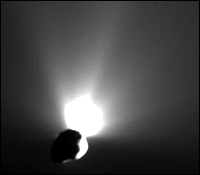 NASA is rightly proud to document the success of
its
Deep Impact mission to comet Tempel 1. Locally,
the Keck Observatory, on the island of Hawai'i, has released
preliminary data. However, since the data are in the
hundreds and thousands of megabytes in size I've decided not
to download it. The initial report indicates the infrared
spectrometer picked up the impact debris immediately and
found the following:
NASA is rightly proud to document the success of
its
Deep Impact mission to comet Tempel 1. Locally,
the Keck Observatory, on the island of Hawai'i, has released
preliminary data. However, since the data are in the
hundreds and thousands of megabytes in size I've decided not
to download it. The initial report indicates the infrared
spectrometer picked up the impact debris immediately and
found the following:
"The IR continuum began to brighten immediately after impact, and brightening continued for the next hour. Spectral lines of H2O appeared almost immediately, and continued to brighten thereafter. The first instrument setting (28 minutes on source) revealed spectral lines of H2O (7 hot-band lines)), C2H6 (5 Q-branches: RQ2, RQ1, RQ0, PQ1, and PQ2), and CH3OH (many lines). The second setting (24 minutes on source) yielded additional hot-band lines of H2O,along with lines of HCN (six lines), C2H2 (tentatively two lines),CH3OH (many lines) and OH prompt emission."
